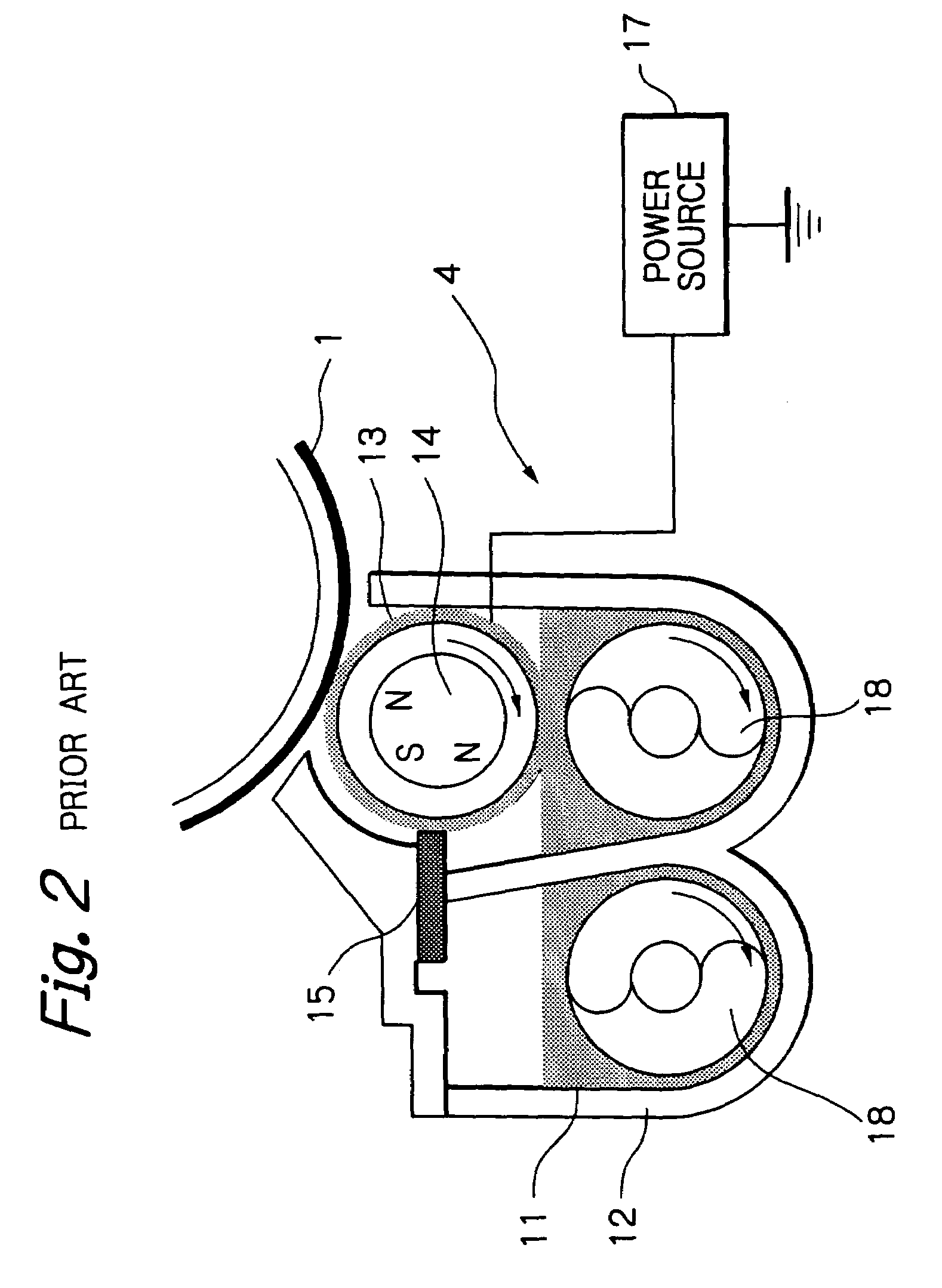Image forming apparatus
a technology of image forming apparatus and magnet brush, which is applied in the field of printers, can solve the problems of unsolved, degrade reproducibility and therefore tonality, and the magnet brush therefore fails to uniformly contact the photoconductive element, so as to and reduce the half width of the main magnetic pol
- Summary
- Abstract
- Description
- Claims
- Application Information
AI Technical Summary
Benefits of technology
Problems solved by technology
Method used
Image
Examples
first embodiment
[0102]This embodiment is mainly directed toward the first object stated earlier. The illustrative embodiment is essentially identical with the image forming apparatus described with reference to FIGS. 1 and 2 as to the general mechanical structure. The structure of FIGS. 1 and 2 will be described more specifically. In FIG. 1, the drum 1 is implemented by, e.g., a conductor coated with a photoconductive material and is rotatable at a peripheral speed of, e.g., 230 mm / sec. The charger 2 includes a roller contacting the drum 1 and a power supply for applying a voltage to the roller. The charger 2 uniformly charges the surface of the drum 1 to a preselected potential, e.g., −0.6 kV. The exposing unit 3 includes a light source, e.g., a laser diode for emitting a laser beam. The laser beam scans the charged surface of the drum 1 in accordance with image data to thereby form a latent image on the drum 1.
[0103]The developing device 4 develops the latent image with toner for thereby forming ...
second embodiment
[0121]This embodiment is identical with the first embodiment except for the additional condition that the charge potential is 1,000 V or below in absolute value.
[0122]Generally, a field strength that insures insulation of OPC (Organic PhotoConductor) often used for an electrophotographic apparatus is between 30 V / μm and 40 V / μm. If the field strength exceeds such a range, then OPC itself looses its function (insulation) or has its life shortened in a long term.
[0123]FIG. 7 shows the results of image estimation conducted by passing 10,000 paper sheets and varying the potential to deposit on a photoconductive element over the range of from 200 V to 1,200 V. The photoconductive element was implemented by OPC and made up of a co-called CTL (Charge Transport Layer) and a CGL (Charge Generating Layer) that were 27 μm thick and 1 μm thick, respectively. A color copier imagio MF4570 available from Ricoh Co., Ltd. was used to print a test chart whose image area ratio was 5%.
[0124]As shown in...
third embodiment
[0125]This embodiment is identical with the first embodiment except for the additional condition that the charge potential is 100 V or below in absolute value.
[0126]FIG. 8 lists the density of black solid images measured by using a developer whose toner was charged to 10 μC / g to 35 μC / g and by varying the bias for development. As FIG. 8 indicates, when the amount of charge to deposit on toner is 10 μC / g to 35 μC / g that reduces both of background contamination and the thinning of a horizontal line omission of a trailing edge, a bias of 100 V or above is necessary for the image density of 1.3 or above to be attained.
[0127]Further, in electrophotographic image forming apparatuses in general, the charge potential and bias for development vary by 20 V to 30 V. Specifically, the charge potential varies due to the wear, i.e., variation in the film thickness of a photoconductive element ascribable to aging and due to the varying environment, particularly humidity. The bias for development v...
PUM
 Login to View More
Login to View More Abstract
Description
Claims
Application Information
 Login to View More
Login to View More - R&D
- Intellectual Property
- Life Sciences
- Materials
- Tech Scout
- Unparalleled Data Quality
- Higher Quality Content
- 60% Fewer Hallucinations
Browse by: Latest US Patents, China's latest patents, Technical Efficacy Thesaurus, Application Domain, Technology Topic, Popular Technical Reports.
© 2025 PatSnap. All rights reserved.Legal|Privacy policy|Modern Slavery Act Transparency Statement|Sitemap|About US| Contact US: help@patsnap.com



